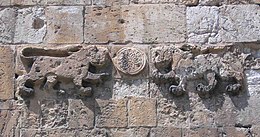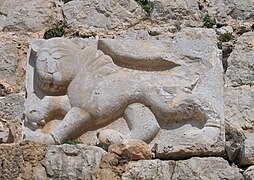金達斯橋
| 金達斯橋 | |
|---|---|
| جسر جنداس | |
 | |
| 座標 | 31°58′07.51″N 34°54′00.78″E / 31.9687528°N 34.9002167°E |
| 承載 | |
| 跨越 | 阿亞隆干河 |
| 地點 | 以色列盧德 |
| 官方名稱 | 盧德橋(希伯來語:גשר לוד) |
| 其他名稱 |
|
| 設計參數 | |
| 橋型 | 拱橋 |
| 全長 | 30公尺 |
| 寬度 | 10公尺 |
| 歷史 | |
| 開通日 | 公元1273年 |
| 地圖 | |
 | |
金達斯橋(阿拉伯語:جسر جنداس,羅馬化:Jisr Jindās),希伯來語稱為盧德橋(希伯來語:גשר לוד,羅馬化:Gesher Lod),別稱拜巴爾橋(阿拉伯語:جسر بيبرس,羅馬化:Jisr Baybars),是位於以色列盧德北出口的古代拱橋,建於公元1273年。該橋跨越阿亞隆干河,向南通往盧德和拉姆拉[1]。該橋得自1948年前位於橋東側[2]的金達斯村[3],該村莊的歷史或可追溯到1129年,當時的一份拉丁文特許狀中提到了「金達斯的『casal』」[4]。金達斯橋是蘇丹拜巴爾一世在巴勒斯坦修建的最著名的橋梁,其他修建的橋梁還有伊卜奈橋和伊斯杜德橋[5]。
歷史
[編輯]該橋建於伊斯蘭曆672年(公元1273年),但據信其地基早在羅馬時期就已建立[6]。1896年,法國東方學家夏爾·西蒙·克萊蒙-加諾首次對該橋進行了現代研究。他指出,一篇阿拉伯編年史提到拜巴爾一世於公元1273年在拉姆利赫附近修建了兩座具有重要意義的橋,以便其軍隊在埃及和敘利亞北部之間通行。兩座橋中一座是本橋,另一座被認為是伊卜奈橋[7]。
萊蒙-加諾得出結論稱,這座橋的石材取自聖喬治教堂的廢墟,該教堂在十字軍與阿尤布王朝戰爭中被摧毀[7]。
橋兩側的中央拱門上方都有一塊長方形石板,上面刻有內容幾乎相同的銘文,銘文兩側的面板上刻有獅子(或豹子)的圖案。東側的銘文如下:
奉至仁至慈的真主之名,願真主保佑我們的主穆罕默德及其家人和同伴!這座聖橋是由我們的主人,偉大的蘇丹馬利克·扎希爾·魯克-丁·拜巴爾,阿布德·穆塔利卜之子,在他的兒子蘇丹王馬利克·賽義德·納西爾丁·巴雷凱·汗的時代下令修建的,願真主頌揚他們的勝利,並賜予他們恩典。這是在渴望真主憐憫的卑微僕人阿拉丁·阿里·蘇瓦格的指揮下進行的,願真主在671年齋月寬恕他和他的父母。
بسم الله الرحمن الرحيم وصلواته على سيدنا محمد وعلى آله وصحبه أجمعين، أمر بعمارة هذا الجسر المبارك مولانا المعظم الملك الظاهر ركن الدين بيبرس ابن عبد الله في أيام ولده مولانا الملك (..) السعيد ناصر الدين بركة خان أعز الله أنصارهما وغفر لهما وذلك في بولاية العبد الفقير إلى رحمته الله علاء الدين السواق غفر الله له ولوالديه في شهر رمضان سنة أحد وسبعين
1882年,巴勒斯坦勘探基金的《巴勒斯坦西部調查》(Survey of Western Palestine)指出,這些雕塑和銘文似乎是撒拉森人的作品[8]。銘文中提到的阿拉丁·阿里·蘇瓦格(Ala al-Din Ali al-Suwwaq)正是三年前負責監督盧德大清真寺建設的官員[9]。
18至19世紀期間,該橋是盧德分區的一條主要道路,該分區從南部的莫迪因馬加比勒特向北延伸至埃爾阿德;從東部的山麓,穿過盧德谷一直延伸到西部的雅法郊區。該地區有大約20個村莊、數千居民,以及數萬公頃的優質農田[10]。
設計
[編輯]金達斯橋長30多公尺,寬10公尺,為南北走向。它由三個拱門門和兩個中央橋墩組成,中間的拱門比兩側的拱門更寬[1]。
雕塑
[編輯]拜巴爾將豹作為紋章,並將其刻在錢幣和建築物上,其原因可能是他的名字在其母語突厥語中意為「大豹」[11]。而金達斯橋銘文兩側的面板上印有一隻在玩弄老鼠的獅子(一說是豹子),其中的老鼠可能象徵著拜巴爾的十字軍敵人[12]。
根據摩西·沙龍的說法,金達斯橋上的獅子與耶路撒冷獅子門和加沙城巴沙宮上的獅子相似,三者都代表著拜巴爾。與金達斯橋上的獅子不同的是,加沙城的獅子上刻有交錯的線條,似乎想體現豹斑;但兩處的獅子都有相似的輪廓。據沙龍估計,它們都完成於公元前1273年左右[13]。
參見
[編輯]參考文獻
[編輯]- ^ 1.0 1.1 Petersen 2001,第183頁.
- ^ Jindas. Zochrot. [2024-03-02]. (原始內容存檔於2024-04-04) (英語).
- ^ Marom, Roy. Jindās: A History of Lydda's Rural Hinterland in the 15th to the 20th Centuries CE. Lod, Lydda, Diospolis. 2022-11-01, 1: 4–6 [2024-01-28]. (原始內容存檔於2023-10-04).
- ^ Clermont-Ganneau 1896,vol.2, p. 117.
- ^ Petersen 2008,第297頁.
- ^ O』Connor 1993.
- ^ 7.0 7.1 Clermont-Ganneau 1896,vol.2, pp.110–117.
- ^ Conder & Kitchener 1882,SWP II, pp. 264–265.
- ^ Petersen 2001,第184頁.
- ^ Marom, Roy. Lydda Sub-District: Lydda and its countryside during the Ottoman period. Diospolis - City of God: Journal of the History, Archaeology and Heritage of Lod. 2022, 8: 103–136 [2024-02-03]. (原始內容存檔於2023-04-15).
During much of the Ottoman period, the subdistrict of Lydda (Lod) was a large administrative unit that stretched from the present-day city of Modi'in in the south to the present-day city of Elad in the north; from the foothills in the east, through the Lod Valley to the outskirts of Jaffa in the west. This area was home to thousands of inhabitants in about 20 villages, who had at their disposal tens of thousands of hectares of prime agricultural land.
- ^ Heghnar Zeitlian Watenpaugh. The image of an Ottoman city: imperial architecture and urban experience in Aleppo in the 16th and 17th centuries. Brill. 2004: 198. ISBN 90-04-12454-3.
- ^ Niall Christie. Muslims and Crusaders: Christianity's Wars in the Middle East, 1095-1382, from the Islamic Sources. Seminar Studies first. Routledge. 2014: 121, Plate 8. ISBN 9781138022744.
Plate 8 jisr jindas, Lydda (Lod), Israel. Built by Baybars in 1273, panels flanking the inscription on this bridge bear his lion/panther blazon. On each panel the lion plays with a rat, possibly intended specifically to symbolize the sultan's Frankish enemies.
- ^ Sharon 2009,p. 58 and pl.6.
參考書目
[編輯]- Clermont-Ganneau, C.S. Le pont de Beibars à Lydda. Recueil d'archéologie orientale: Clermont-Ganneau, Charles. Paris: Ernest Leroux. 1888. (editio princeps)
- Clermont-Ganneau, C.S. [ARP] Archaeological Researches in Palestine 1873–1874, translated from the French by J. McFarlane 2. London: Palestine Exploration Fund. 1896.
- Conder, C.R.; Kitchener, H.H. The Survey of Western Palestine: Memoirs of the Topography, Orography, Hydrography, and Archaeology 2. London: Committee of the Palestine Exploration Fund. 1882.
- Marom, Roy. Jindās at Lydda's Entrance: A Cornerstone of the Study of the City's Rural Hinterland (1459 – 1948). Diospolis. 2021, 7: 9-43 [2024-03-02]. (原始內容存檔於2023-04-11).
- Marom, Roy. Jindās: A History of Lydda's Rural Hinterland in the 15th to the 20th Centuries CE. Lod, Lydda, Diospolis. 2022, 1: 1-31 [2024-03-02]. (原始內容存檔於2023-10-10).
- O』Connor, Colin. Roman Bridges. Cambridge University Press. 1993. ISBN 0-521-39326-4.
- Palmer, E.H. The Survey of Western Palestine: Arabic and English Name Lists Collected During the Survey by Lieutenants Conder and Kitchener, R. E. Transliterated and Explained by E.H. Palmer. Committee of the Palestine Exploration Fund. 1881.
- Petersen, Andrew. A Gazetteer of Buildings in Muslim Palestine (British Academy Monographs in Archaeology) 1. Oxford University Press. 2001 [2024-01-28]. ISBN 978-0-19-727011-0. (原始內容存檔於2021-05-29).
- Petersen, Andrew. Bridges in Medieval Palestine. U., Vermeulen; K., Dhulster (編). Egypt and Syria in the Fatimid, Ayyubid and Mamluk Eras VI. Peeters. 2008: 291–307 [2024-01-28]. (原始內容存檔於2021-12-01).
- Sharon, M. Corpus Inscriptionum Arabicarum Palaestinae, B-C 2. BRILL. 1999: 229 [2024-03-02]. ISBN 90-04-11083-6. (原始內容存檔於2023-08-03).
From Ramlah the route continued to Ludd (Lydda) and over a bridge (near Jindas) to the north of the city built in 1273, up to the khan of Jaljulyah, built around 1325.
- Sharon, M. Corpus Inscriptionum Arabicarum Palaestinae, G 4. BRILL. 2009. ISBN 978-90-04-17085-8.



